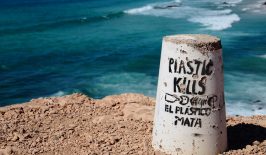Last month, researchers released information which explained why sea turtles appear to be attracted to plastic in the sea, with the reptiles seemingly confusing the smell of the plastic for their food source. But turtles are by no means the only animal affected by plastic waste in our seas and oceans, with many species being found to have ingested huge amounts of plastic.
Every year, about eight million tons of plastic waste ends up in the world’s oceans – in addition to the estimated 150 million tons already found in marine ecosystems. A large part of this ocean plastic is made up of so-called “ghost nets”, discarded fishing nets that have been left in the sea. It is estimated that about 30 to 50 percent of the plastic in the sea consists of these discarded nets.
Finding and recovering these nets is an important task as they pose a serious risk to many creatures that live in the ocean, trapping and killing sharks, rays, crustaceans, dolphins, whales and birds. That’s the incentive behind WWF Germany’s new Ghostdiver app, which taps into the power of the crowd to help tackle the problem. Fishermen, hobby divers and other water sports fans can use the app to report the location of ghost nets and other discarded objects on a map, and verify the location of previously reported marine waste. As well as registering the location, they can also upload information such as coordinates, diving depth, a short description and photos of what they have found. Professional salvage divers can then go and check on the find and if possible, retrieve them from the sea.
In the Baltic Sea alone, the WWF has already recovered over nine tons of ghost nets in recent years. The app is initially limited to the area of the Baltic Sea, but next year it is will also be extended to the North Sea. “Together with the users of the app, we can achieve our goal of ridding the North Sea and Baltic Sea of ghost nets,” says Gabriele Dederer, WWF’s ghost net expert. Although fishing nets used to be made of degradable materials such as hemp or linen, plastic composites have become the material of choice since the 1960s. Like so many synthetic materials, plastic nets decompose over a period of several hundred years, contributing to plastic waste and constituting a major cause of microplastics in our oceans, as they disintegrate into ever-smaller pieces over time.
Ghost Nets and Illegal Fishing
But why do so many fishing nets end up in being left in the sea in the first place? Some nets break away from fishing vessels, get caught somewhere on the seabed or are torn from their moorings during storms. But it’s much more common for them to simply never be retrieved, left out at sea rather than being returned to the harbour to be properly disposed of or maybe even repaired. Illegal fishing is also a cause, as it’s often carried out at night when the darkness and poor visibility means nets are difficult to recover. And when illegal fishing operations are discovered and interrupted, nets are often cut to allow the culprits to escape as quickly as possible.
According to a study by Greenpeace, six percent of all nets used, nine percent of all traps and 29 percent of all longlines end up in the oceans as marine waste. Another study by The Ocean Cleanup, from Dutch environmental entrepreneur Boyan Slat, examined the Great Pacific Garbage Patch, the world’s largest collection of plastic garbage in the ocean between Hawaii and California. Here, old fishing nets account for 46 percent of the waste floating in the sea.
So, the impact of floating ghost nets on our marine ecosystems is enormous – as are the challenges of collecting up these nets and either recycling them or disposing of them in an eco-friendly way. But, hopefully, with the support of the volunteer ocean cleaners who download the app, the necessary data will be collected and little by little, oceans will freed from them in a targeted and strategic way. The Ghostdiver app is available as a free download for Android and iOS.
This is a translation by Mark Newton of the original article which first appeared on RESET’s German-language site.






